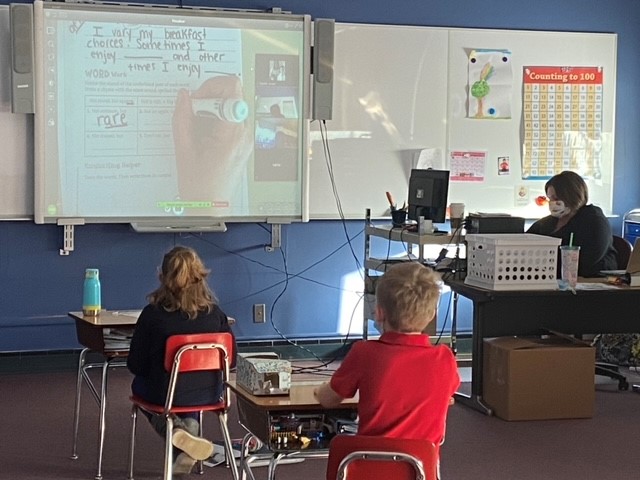
A teacher at Mary Queen of Saints Catholic Academy uses her document camera to project work onto the Smartboard for students in the classroom to see. At the same time, students learning from home can see the same worksheet as the teacher writes on it. (Submitted photo)
After schools re-opened following the initial shut down of the COVID-19 pandemic, leadership at Seton Catholic Schools wanted to bring all of their students back into the classroom as soon as the health department said it was safe, but they weren’t sure how.
Beyond safety for students in the classrooms, they had no expectation of operating at 100 percent in the fall, knowing there would be many families who weren’t comfortable returning yet due to health concerns.
With that in mind, the administration spent all summer trying to solve the two biggest problems they’d been presented: developing safety plans to ensure that every student would be protected, and inventing a brand new way of teaching to accommodate virtual and in-person learners who would have class at the same time.
Courtney Albright, the director of curriculum for Seton Catholic Schools said they started just before summer began, by looking at models of teaching that already existed. First, they explored the idea of exclusively having a digital school, with some teachers working from the building and some from their homes. The idea was quickly abandoned, knowing that essentially running two schools would be too much for teachers and staff. Then they moved to the idea of having teachers teach virtual and in-person students separately; it seemed the only thing to do.
They would teach the subject to kids in school, and have those children work quietly while they moved on to teach students who were at home. A handful of teachers started out this way but the administration saw how overworked teachers got, and relying on previous research they’d done on the social and emotional impact of teachers in the classroom, they knew it wasn’t the way to go.
That’s when they turned to another idea they’d been developing for their schools, something they’d only seen in colleges: concurrent teaching.
The concept behind concurrent teaching is to instruct students in person and those learning from home at the same time, while allowing both groups of students to interact with one another.
“What we have now really evolved from better instructional practices,” Albright said. “Virtual kids really feel like they’re in school and students in the classrooms develop relationships with those at home.”
The teacher puts all the children who are learning from home on a Zoom board that’s projected at the front of the room while she or he teaches. Everyone raises their hands, is called on, and can interact with one another the way they would during a typical year.
“It’s more authentic instruction,” Albright said. “Students at home can ask a question, and students learning from the classrooms can respond. Hearing those student voices is really what we wanted.”
The research that started in August began with Albright setting up a mock classroom with teachers acting as students. They recorded the classes and discussed what worked best and how they could improve. Right away, they named it as a best practice.
Teachers quickly saw that concurrent teaching is much more beneficial to the individual student and the development of the community, not only in academic gain but to the overall student, teacher and classroom health.
“Recently, we were able to get a grant to get some technology that made it much easier for teachers, based on research we’d done in the first semester,” Albright said. “It made it so it was a more authentic collaboration between students learning at home and in the classroom.”
Due to the grant, Seton was able to offer teachers the opportunity to choose from a list of technology that would specifically support their teaching at their grade level and subject area. The bank of technology was acquired after teachers and school leaders met together and discussed what technology would work best for their particular classrooms. “It was almost like Christmas for the teachers,” Albright said.
Technology like Logitech cameras, iPads, Bluetooth headsets, mobile workstations, document cameras and drawing tablets with styluses are just a few of the options teachers were given.
Research done by Seton Catholic Schools has shown that kids overwhelmingly learn best in the classroom, but these new developments open up a new world of opportunities for children going forward, even after schools are at 100 percent capacity again. Albright said there have unfortunately been many cases in the past where children have illnesses or issues that keep them away from school for an extended period of time. Now, she says, there is a solution. With Chromebooks for every student, and internet access for any family who needs it, families will be able to utilize technology and be with their class if they ever have to be away.
“Our teachers are amazing,” Albright said. “It’s not been an easy thing, but they’ve put their all into this and it shows.”
Kiley Lorenz, a first-grade teacher at St. Thomas Aquinas Academy, started the year with 20 in-person students and eight virtual. She said it was stressful trying to figure out how to merge two worlds into one.
“Since then, I’ve found my Bluetooth headset and Bluetooth mouse to be a life saver,” she said. “The headset allows me to walk away from my computer, while still being able to hear my virtual students in my ear and my virtual students can still hear me even when I’m across the room.”
Lorenz, like many of the teachers at Seton, is ending her year in a way she never imagined she could when it began, with a classroom full of students who have close ties to one another and to her, developed as they spend their year learning and conquering every obstacle that came their way.
